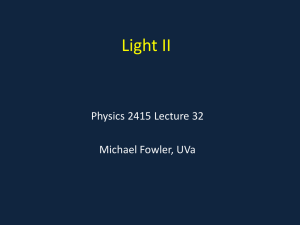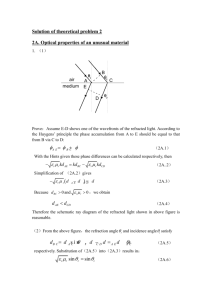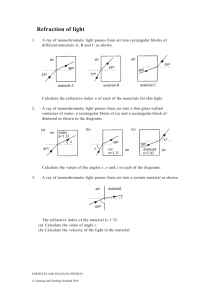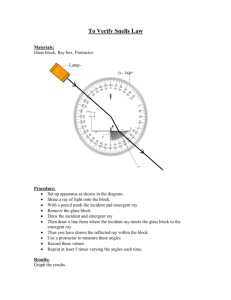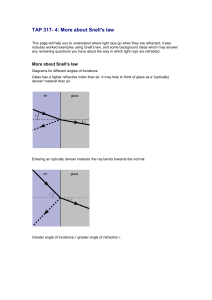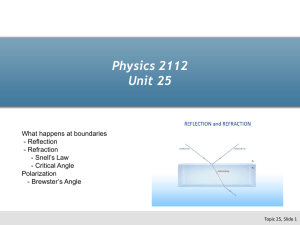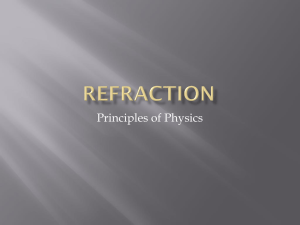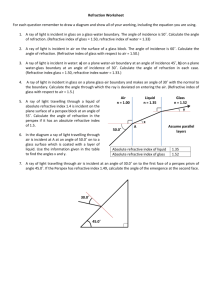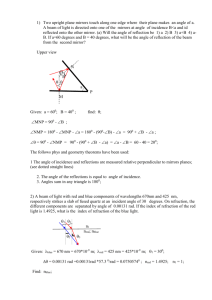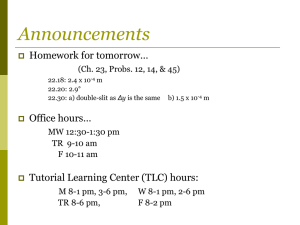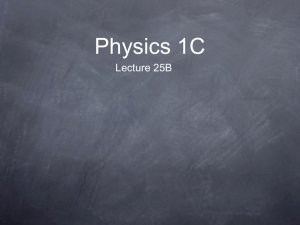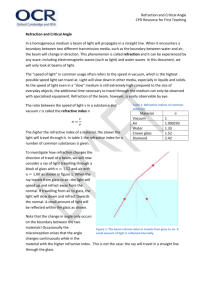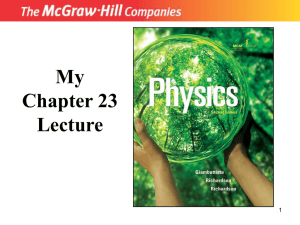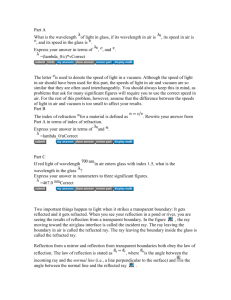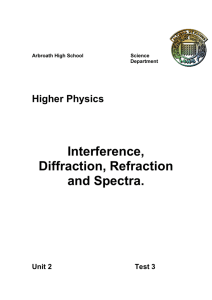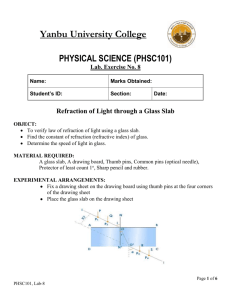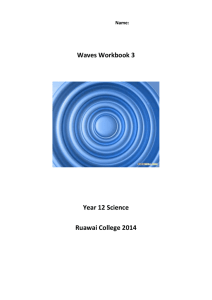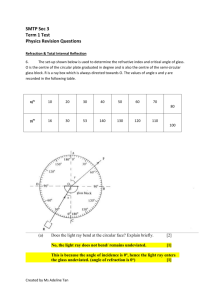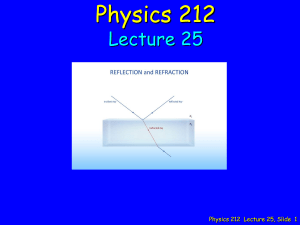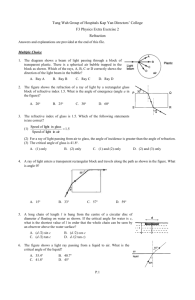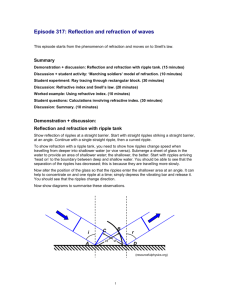TAP 318 - 1: Ray tracing on the way out
advertisement
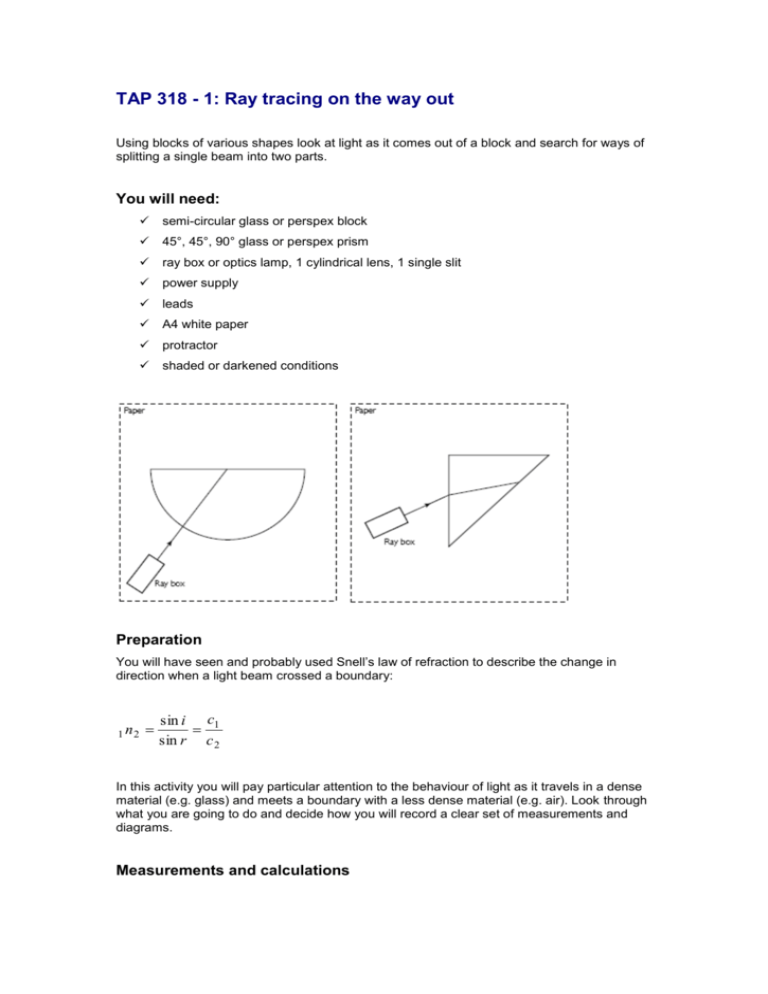
TAP 318 - 1: Ray tracing on the way out Using blocks of various shapes look at light as it comes out of a block and search for ways of splitting a single beam into two parts. You will need: semi-circular glass or perspex block 45°, 45°, 90° glass or perspex prism ray box or optics lamp, 1 cylindrical lens, 1 single slit power supply leads A4 white paper protractor shaded or darkened conditions Preparation You will have seen and probably used Snell’s law of refraction to describe the change in direction when a light beam crossed a boundary: 1 n2 sin i c1 sin r c 2 In this activity you will pay particular attention to the behaviour of light as it travels in a dense material (e.g. glass) and meets a boundary with a less dense material (e.g. air). Look through what you are going to do and decide how you will record a clear set of measurements and diagrams. Measurements and calculations It is possible to arrange the path of a ray of light through the blocks in such a way that you can see clearly what is happening as it is about to emerge into the air. Semicircular block Place a semicircular block on the paper and mark its straight edge. Arrange the angle of the light so a ray enters the curved surface of the block along a radius. It will then meet the straight side at its centre. Observe what happens as you gradually rotate the block so that the ray meets the straight side at different angles. You should notice that some light is reflected back into the block. Depending on the angle, some light might emerge, or it might all be totally internally reflected. Choose three different situations: 1. quite a lot of light emerges 2. all the light is internally reflected 3. a critical point where a beam just splits into reflected and refracted beams. In each case: Mark the paths of the incident, reflected and refracted light. Draw the normal to the straight side of the block Measure the angles of incidence, reflection and refraction at the exit point. Talk to your fellow students about what is happening when the beam just splits. Could you have predicted your observations using Snell’s law? When the ray just manages to emerge at 90° to the normal, the angle between the ray and the normal inside the block is called the critical angle, C. Triangular prism Change to the 90° angle prism. Shine a ray of light into it and look for the rays that do not leave the block at the first internal boundary but are only reflected. Sketch examples of this happening. Questions 1 Name the angles X, Y and Z 2 Write down all the relationships you know, or can derive, between X, Y and Z. 3 If X is gradually increased, what happens to the sizes of Y and Z? What happens to the light? 4 Use Snell’s law to derive an expression relating the sine of the critical angle to the refractive index of the glass, ang. Practical advice This is a standard practical exercise used to measure critical angles and explore internal reflection, and to reinforce earlier work using Snell’s law and sines. We suggest that students produce a summary using notes and diagrams for their own use This Java applet shows transmission and reflection of waves at a boundary, showing wavefronts as summations of scattered wavelets: http://www.phy.ntnu.edu.tw/java/propagation/propagation.html Answers and worked solutions 1 X = angle of incidence. Y= angle of reflection. Z = angle of refraction. 2 X = Y. a=air, g =glass. sin X g na sin Z the refractive index from glass to air sin Z a ng sin X the refractive index from air to glass The latter is what we normally refer to as ‘the refractive index of glass’ 3 As X increases, Y and Z also increase. Once Z reaches 90° (at which point X and Y will still be less than 90°), then the beam is no longer split but is totally internally reflected. You may observe colours in the beam as 90° is reached. 4 For Z = 90O then X = C (the critical angle) so from Snell’s Law sin Z a ng sin X so sin 90O = 1 so sin 90 0 a ng sin C 1 a ng sin C External reference This activity is taken from Salters Horners Advanced Physics, section TSOM, activity 24
